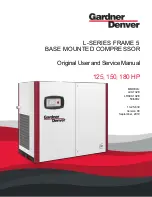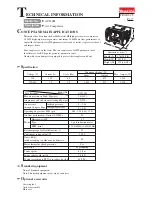
The OSCD control system is composed of various components located within both the Control
Center and the OSCD. In this way, the Control Center integrates with the OSCD. The OSCD system
uses various microprocessors, which are linked together through a network of communications
links.
The Control Center before 2005
The Control Center contains two boards that act upon OSCD related information, the Microboard
and the Adaptive Capacity Control board (ACC). The ACC board performs two major functions in the
OSCD control system:
•
To act as a gateway for information flow between the Control Center and the OSCD
•
To determine the optimum operating speed for maximum chiller system efficiency
The ACC board acts as an information gateway for all data flowing between the OSCD and the
Control Center. The ACC board has a communication link to the OSCD logic board, and one
communication link from the optional Harmonic Filter logic board. When the ACC board receives
the information, the information is passed onto the Control Center by a software communication
link. The Microcomputer Control Center communicates in a parallel fashion through two ribbon
cables connecting the ACC board to the Microboard. The OptiView™ Control Center communicates
through communications port through a bidirectional serial port through a three-wire cable that
connects the ACC board to the Microboard.
To achieve the most efficient operation of a centrifugal compressor, the speed of the compressor
must be reduced to match the lift or head of the load. This lift or head is determined by the
evaporator and condenser refrigerant pressures. However, if the compressor speed is reduced
too much, the refrigerant gas will flow backwards through the compressor wheel causing the
compressor to surge, which is an undesirable and extremely inefficient operating condition. As
a result, one particular optimum operating speed exists (on the edge of surge) for a given head,
which provides the optimum system efficiency.
The compressor’s inlet guide vanes, which are used in fixed speed applications to control the
amount of refrigerant gas flowing through the compressor, are controlled together with the
compressor speed on an OSCD chiller system to obtain the required chilled liquid temperature
while simultaneously requiring minimum power from the AC line.
The ACC board automatically generates its own “Adaptive”three-dimensional surge surface map
while the chiller system is in operation. This “Adaptive” operation is accomplished through the
use of a patented surge detection algorithm. The novel surge detection system uses pressure
information obtained from the chiller’s two pressure transducers or the OSCD’s instantaneous
power output to determine if the system is in surge. The adaptive system permits construction of
a customized compressor map for each individual chiller system. The benefits of this new adaptive
system include the following:
•
A customized compressor map for each chiller that eliminates inefficient operation due to the
safety margin built into the previous designs to compensate for compressor manufacturing
tolerances
•
The ability to update the system’s surge surface as the unit ages
•
Automatic updating of the compressor map if changes in refrigerant are implemented at a
later date
The Control Center beginning in 2005
A major change in the control system took place in 2005. Several redesigns took place in the
OptiView panel and the OSCD. The redesign replaced microprocessors that were becoming
obsolete. This was a time to take advantage of new components that were now available. An
additional communications port was added so that the communications between the microboard
Liquid-Cooled OptiSpeed Compressor Speed Drive
18
















































